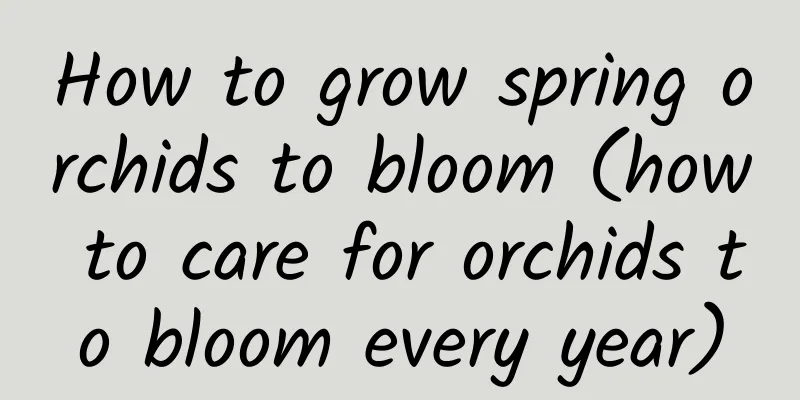How to grow spring orchids to bloom (how to care for orchids to bloom every year)

Remove weak and retain strong to promote flower budsAt the end of May to the beginning of June every year, the first batch of spring buds emerge from the soil and grow. The organic nutrients produced by photosynthesis of the mother plant are first allocated for its own growth, then for the growth of seedlings, and finally stored in the pseudobulb. The excess nutrients will be used to germinate new leaf buds and flower buds. Understanding this principle, we should consider how to promote the growth of flower buds and inhibit the germination of leaf buds. Generally speaking, under the conditions of sufficient light and water and fertilizer supply, the second batch of leaf buds of spring orchid will emerge and grow in late June and early July. However, the flower buds have not yet reached the time to germinate, and these leaf buds are weak buds, with only 2 to 3 leaves. Keeping them is not conducive to the growth of spring orchid buds, and it will also waste the nutrients in the pseudobulb, so they should be removed in time. However, to adopt the above method to promote flower buds, the orchid plants should meet two basic conditions: first, there should be more than 3 spring orchid seedlings in a cluster; second, the orchid plants should have a well-developed root system. It is worth noting for orchid lovers that, based on the actual orchid cultivation situation in the local area, it is more appropriate to pull out the weak leaf buds about 15 to 20 days before the first batch of flower buds emerge. Common practices to promote orchid floweringFrom early August to early August, when the leaf buds of spring orchid grow to about 3 cm, the number of leaves is already clearly visible. We will pull out all the leaf buds with 3 to 4 leaves, and only keep the strong buds with more than 5 leaves. At this time, the nutrients in the orchid plant will be redistributed, giving the flower buds hidden in the reed head a chance to sprout and develop. By the end of August to the end of September, you can see many flower buds breaking through the soil from the orchid. Orchid flowering 4 requirementsOf course, in addition to the above-mentioned methods of promoting flower buds, the four basic requirements for orchid growth should also be guaranteed. First, the nitrogen fertilizer content in the planting material should not be too much, while the phosphorus and potassium fertilizers are too little, which will lead to excessive vegetative growth and inhibited reproductive growth. Second, do not water too much during the flower bud differentiation period, and it is better to keep the planting material slightly moist and slightly dry. Third, from late autumn to winter and spring, the light provided to orchids should be sufficient to maintain the accumulation of nutrients needed for their reproductive growth. The last point is that the temperature difference between day and night must meet the requirements. In short, in order to ensure the flowering of spring orchids grown indoors, you should ensure that the orchid plants are planted in clusters of more than 3 seedlings to keep the orchid's root system relatively developed and strong. On this basis, the weaker leaf buds that have sprouted out of the soil should be removed to concentrate nutrients and give the flower buds hidden on the pseudobulbs the opportunity to sprout and develop, thereby promoting the sprouting of the flower buds of the orchid plant. In addition, the fertilizer supply of the planting material is appropriate, and the phosphorus and potassium fertilizers are rich in nutrients; the amount of watering is controlled during the flower bud differentiation period; sufficient sunlight is provided, and the temperature difference between day and night is guaranteed to meet the requirements. Only in this way can the spring orchid be guaranteed to bloom well. |
<<: How to keep leaf-cut succulents alive (how to keep them growing well and fast)
Recommend
How to prune Wanchongshan
When to prune Wanchongshan If you want to prune W...
What fertilizer is best for roses?
There are some skills to growing such tall roses,...
Where do blueberry seeds come from?
Where do blueberry seeds come from? Blueberry see...
How to care for spider plants in winter
Is Chlorophytum afraid of cold? The suitable temp...
The role of red flower jade in home furnishing
The ornamental effect of red flower jade If you w...
How much do you know about Feng Shui for growing flowers at home?
living room The living room should be more partic...
How to plant wild apricot seeds
1. Obtaining seeds From June to July every year, ...
Which plants can move?
sunflower The sunflower gets its name because the...
How to grow lucky bamboo to make it more vigorous
Appearance What does a lucky bamboo look like whe...
How to take care of the newly bought Schefflera
1. Change the soil When you first buy the Scheffl...
What should I do if the camellia does not grow?
1. Why does camellia not grow? 1. Inappropriate a...
How to take care of the newly bought money tree
1. Change the soil Money tree does not have high ...
How and when to plant beans outdoors? When is the latest time to plant beans outdoors?
Suitable time for planting beans in the open air ...
Do you need to trim the leaves of white palm?
1. Do you need to trim the leaves? During the gro...
Podocarpus meaning
1. Attracting Wealth The Podocarpus plant is tall...









